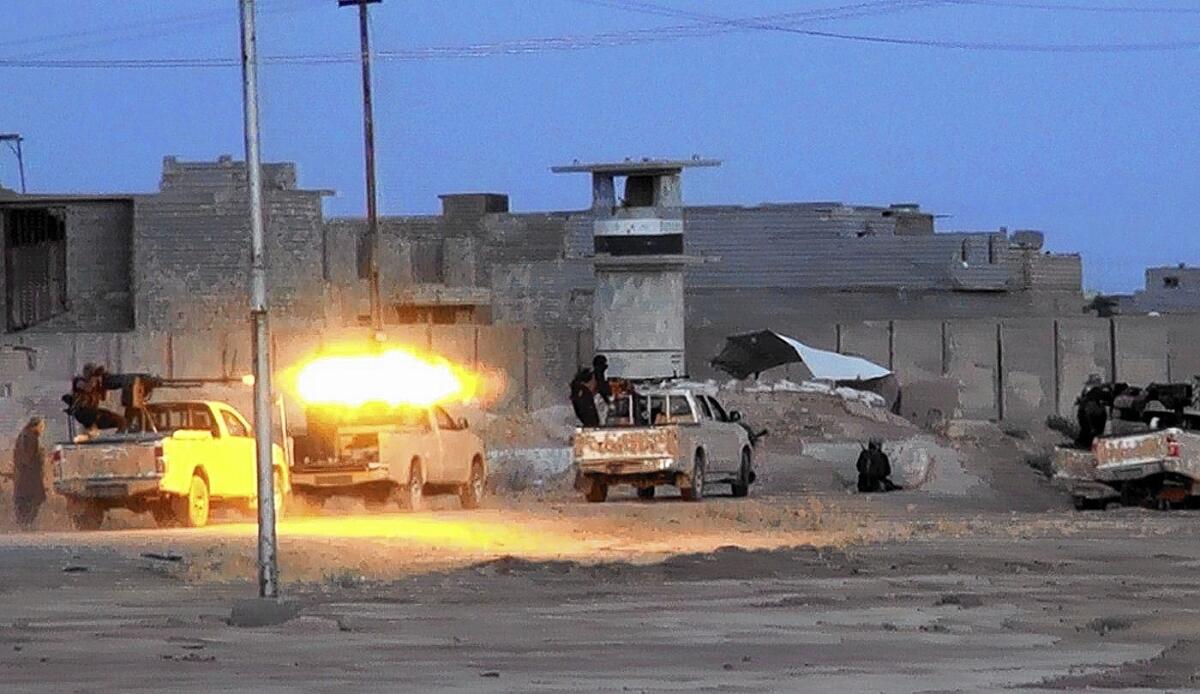Abu Bakr Baghdadi’s reach shows power of regional militant groups

- Share via
He is regarded as one of the most powerful militants in the world, a former Islamist preacher who evolved into a global jihad warrior now threatening to rewrite the map of the Middle East.
Yet Abu Bakr Baghdadi, the head of the Islamic State of Iraq and Syria, remains largely a mystery, even to his followers.
------------
FOR THE RECORD:
Abu Bakr Baghdadi: An article in the June 14 Section A about Abu Bakr Baghdadi, leader of the insurgent group Islamic State of Iraq and Syria, said that Aron Lund is the editor of the Carnegie Endowment’s Syria in Crisis website. Lund is no longer the editor, but sometimes writes for the website.
------------
Unlike with such iconic figures as Al Qaeda leaders Osama bin Laden and Ayman Zawahiri, only two photos are known to exist of Baghdadi, showing a trim-bearded man with thick eyebrows. Baghdadi, whose fighters have seized large swaths of territory in both Syria and Iraq, releases only audio messages. Even when he meets with ISIS commanders, Baghdadi is said not to reveal himself.
During such sessions, several men whose faces are covered to conceal their identities are said to enter the room, listen without speaking and then leave. The commanders are simply told that “one of these was Baghdadi, and he heard what you wanted and he will respond at a later time,” said Abu Ibrahim Raqqawi, an opposition activist in Raqqa, Syria, where ISIS has established what it views as the capital of a burgeoning transnational Islamist caliphate.
“No one deals with him except leaders at the highest level,” Raqqawi said.
The emergence of ISIS illustrates the growing importance of regional militant groups. Several of these have eclipsed Al Qaeda’s central command, which has been battered by U.S. drone strikes and other attacks aimed at its strongholds in Pakistan.
U.S. officials long have worried about a group based in Yemen, Al Qaeda in the Arabian Peninsula, and expressed growing concern about Al Qaeda in the Islamic Maghreb, based in Algeria and Mali. The rising prominence of such regional groups, including the Al Qaeda branches, has corresponded in part with internal criticism of Zawahiri as an inadequate successor to Bin Laden.
Baghdadi’s fighters have made brutality their calling card, executing detainees in public squares and crucifying some victims. The current fighting brings him back to familiar turf. His path was shaped by the 2003 U.S.-led invasion of Iraq and included time in a U.S.-run prison.
Born in Samarra, Iraq, in 1971, Baghdadi holds a doctorate in Islamic studies from the Islamic University in Baghdad and worked as a teacher and Sunni Muslim preacher before the invasion that toppled the Sunni-dominated government of Saddam Hussein, according to an unofficial biography that has circulated on militant web sites.
The name Baghdadi — his full name is Ibrahim Awwad Ibrahim Ali al Badri al Samarri — signifies his ties to the Iraqi capital. Baghdadi first fought the Americans and then the emerging Shiite-run Iraqi government as a member of the Mujahedin Army, an Islamist force with nationalistic rather than global ambitions.
“He wasn’t this globalist jihadist going to Afghanistan, but he was recruited during the Iraq war,” said Aron Lund, editor of the Carnegie Endowment’s Syria in Crisis website. “The war essentially came to him.”
Baghdadi is believed to have served time in the U.S.-run prison Camp Bucca during the war, and it was there, militant sources say, that he joined a nascent Al Qaeda branch known as Al Qaeda in Iraq, founded by Abu Musab Zarqawi, who was killed in a 2006 U.S. airstrike. Zarqawi led a bloody campaign of suicide bombings, kidnappings and hostage beheadings against Shiites and Americans.
In 2010, when another Islamic State of Iraq leader was slain, Baghdadi was elected the group’s leader.
Surviving under U.S. occupation meant taking on a secretive existence, and Baghdadi continued that once he took over the helm, said Lund.
“The Islamic State of Iraq grew out of an environment when the U.S. had agents on the ground and drones in the air, and they had nowhere to go, they had no safe areas at all,” Lund said. “And Zarqawi tried being the public leader because he was already known, but then the people who followed him were all using fake names.”
Among the thousands of fighters spread across Syria and Iraq, many of them foreigners, Baghdadi is now referred to as the “emir of the believers,” a title first given to the prophet Muhammad, said Somsam Islam, a fighter with a rival Islamist Syrian militant group, the Al Qaeda-affiliated Al Nusra Front.
ISIS was affiliated with Al Qaeda until Baghdadi rebranded the franchise and went international by entering the fray in neighboring Syria in April 2013. Introduction of the Islamic State of Iraq and Syria was made in customary Baghdadi fashion: a 23-minute video consisting of the group’s black and white flag flapping over an audio statement.
Al Qaeda chief Zawahiri unsuccessfully ordered ISIS to cease operations and return to Iraq. But Baghdadi refused and after this somewhat inauspicious beginning, ISIS forces violently seized control of large swaths of northern Syria.
Though its leader remains secretive, ISIS has used social media such Twitter and YouTube to recruit seasoned and first-time Sunni fighters from around the world, including North Africans, Europeans and a large group of Chechens. These fighters have been lured by recruitment videos portraying Syria as a showdown between Sunnis on one side and Shiites and Alawites on the other.
In Syria, ISIS is at odds with most other opposition groups, including militant Islamists from Al Nusra Front, as well as the government of President Bashar Assad.
In a January audio message after weeks of deadly clashes between ISIS and other militants, Baghdadi tried to ease the tension. He urged his fighters to cease battling rebels who laid down their weapons “and forgive and reconcile so you fight a depraved enemy,” meaning Assad.
Yet if anything, ISIS has managed to consolidate its territorial holdings in northeast Syria near the border with Iraq. As it seizes cities in Iraq, including Mosul and Tikrit, the hometown of Hussein, the border between the two nations has become somewhat of a fiction.
Just as he exploited power vacuums in opposition-held parts of Syria to establish a foothold, Baghdadi is now capitalizing on sectarian politics in Baghdad and an alienated Sunni population to seize northern Iraqi territory at a stunning pace.
His success at shaping ISIS has allowed him to present himself as one of the most important of a new generation of Islamic militants, rivaling Zawahiri, said Charles Lister, a visiting fellow at the Brookings Doha Center.
A decade after Baghdadi was reportedly under American detention, the U.S., which designated him a global terrorist in 2011, is offering a $10-million reward for information aiding in his capture or killing. The sum is second only to that offered for Zawahiri.
Follow @RajaAbdulrahim for news from the Middle East
More to Read
Sign up for Essential California
The most important California stories and recommendations in your inbox every morning.
You may occasionally receive promotional content from the Los Angeles Times.











